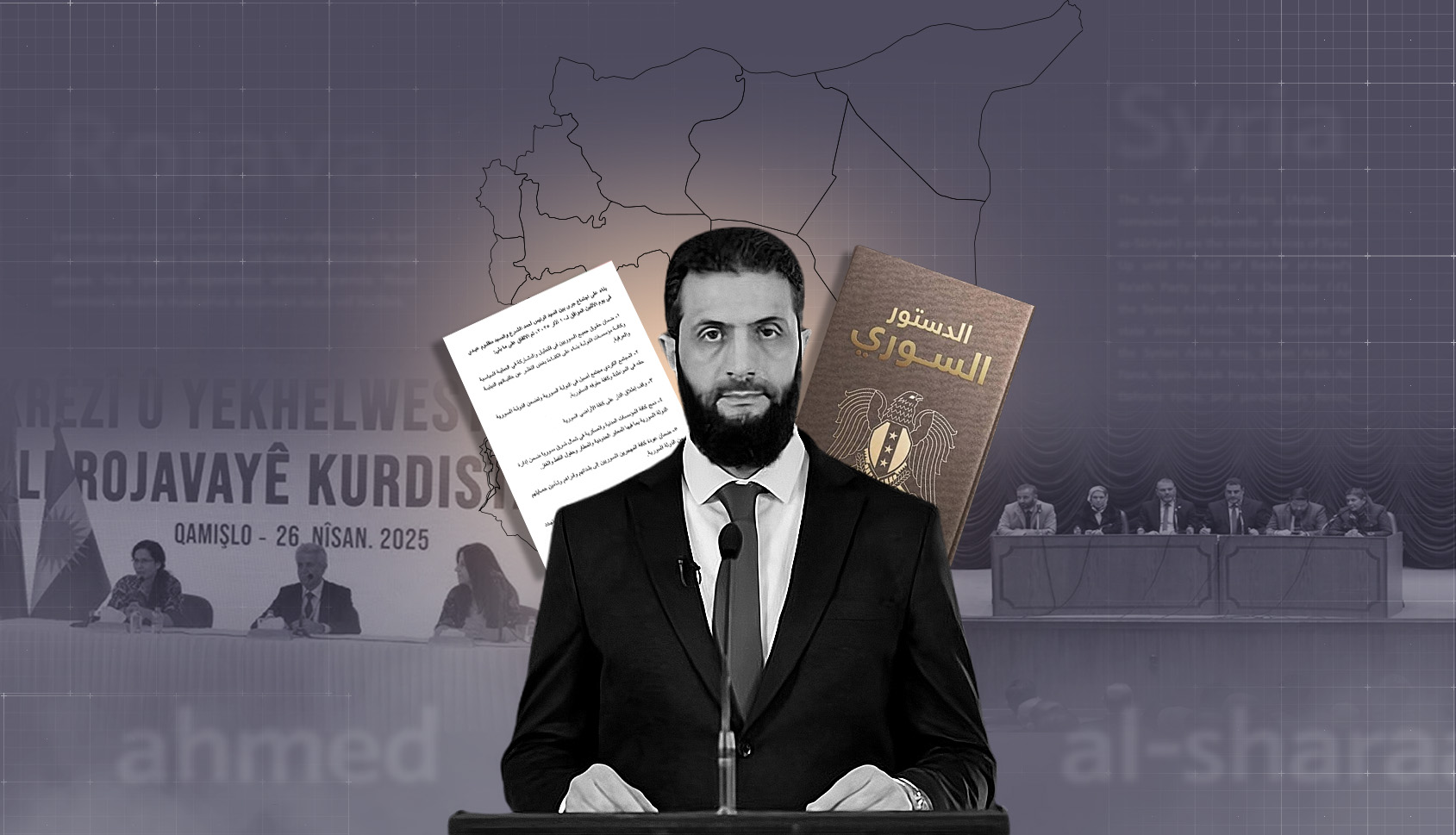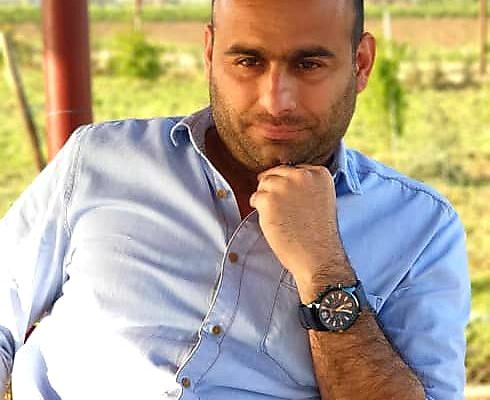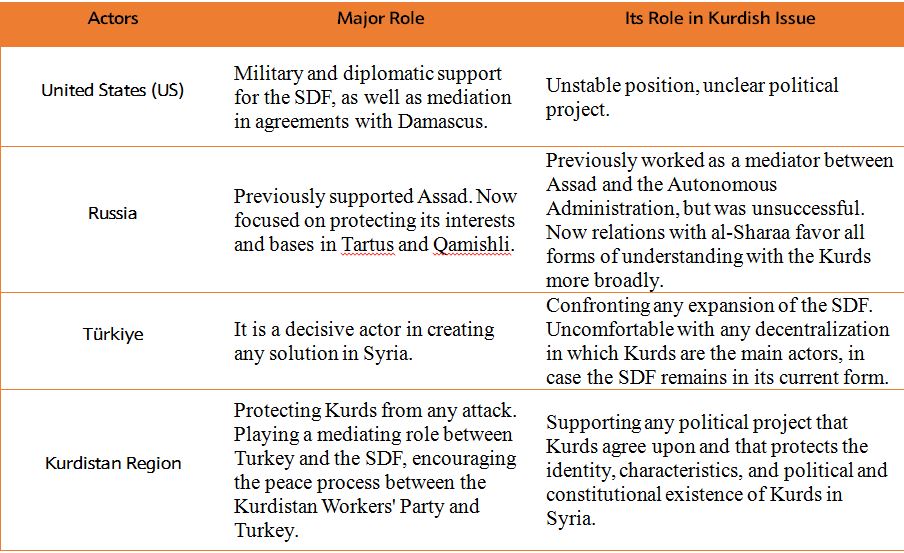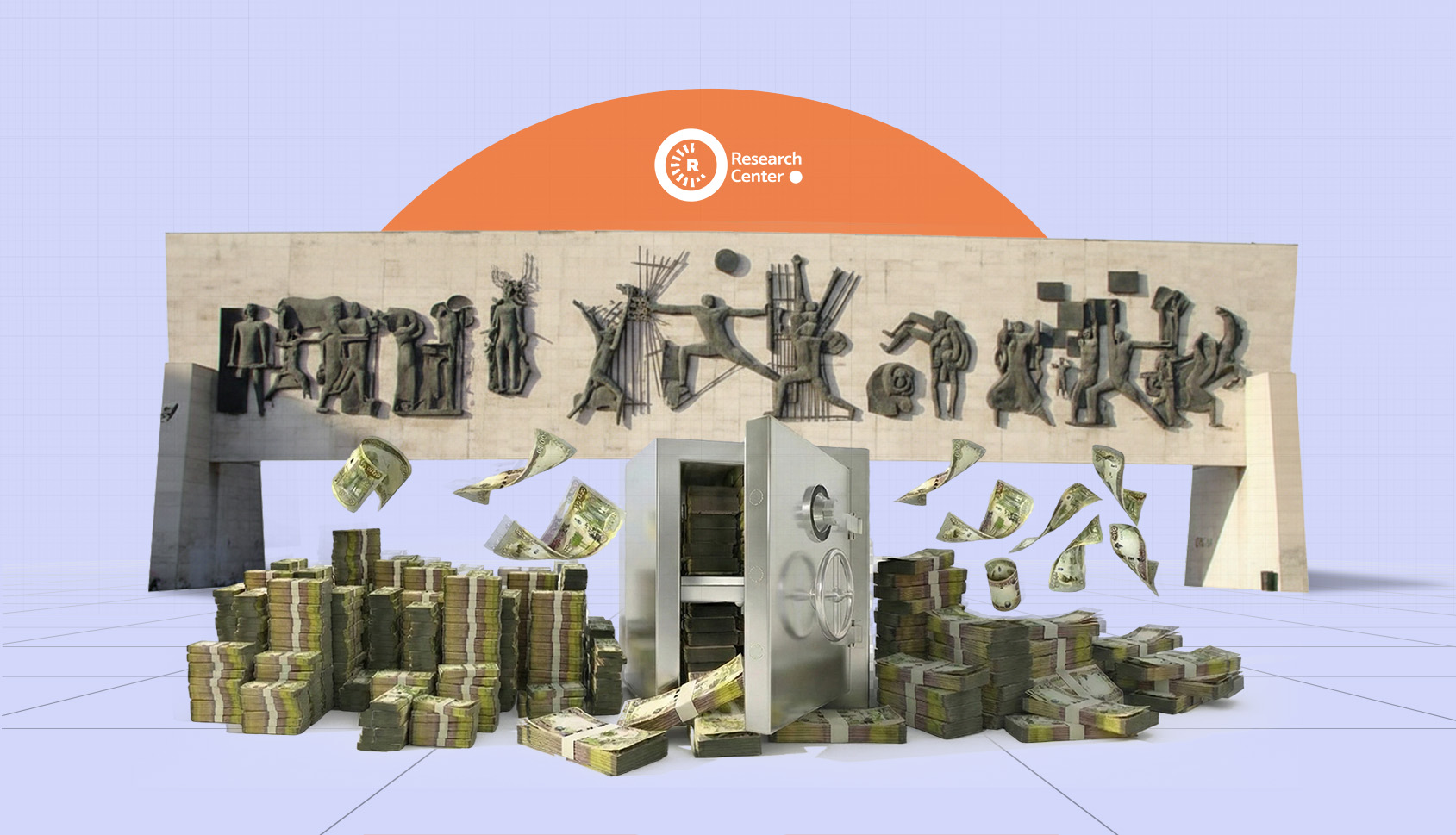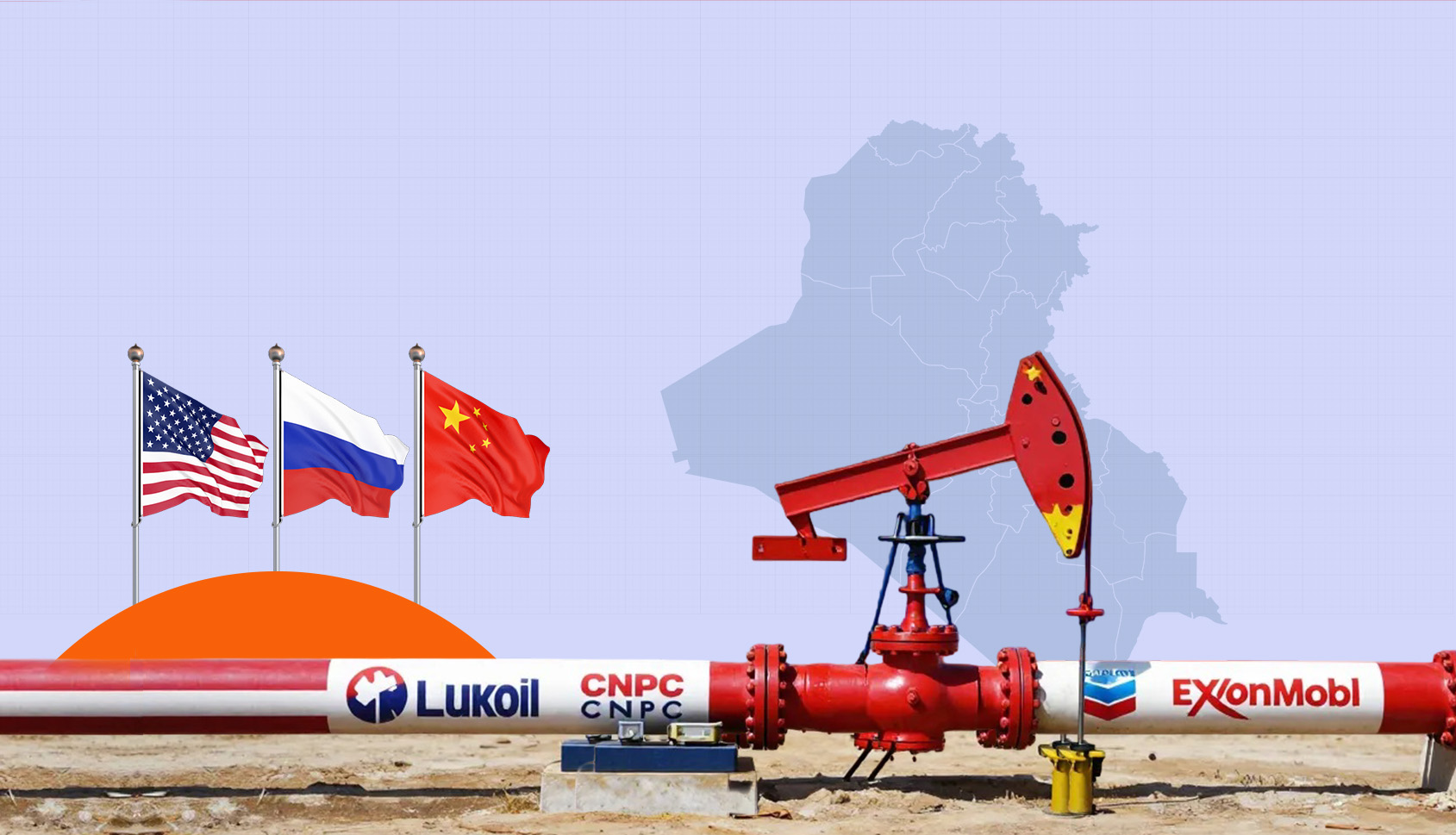The Stalemate in Damascus–Kurdish Relations: Political Calculations and the Consequences of Change
27-08-2025
Following the Kurdish Unity and Solidarity Conference in Qamishli and the formation of a unified Kurdish delegation, the relationship between Damascus and Qamishli, on one hand, and the political and military relations in the Syrian Kurdish region have entered a phase of evident political deadlock. This deadlock raises a fundamental question: Is this a deliberate strategic choice adopted by both sides, or is it the result of failed negotiations and the loss of mutual will to reach some form of understanding? This comes at a time when constitutional drafting is expected to dominate the main platform of discussions and play a central role in drafting and addressing a set of issues, including determining the level of decentralization, the role of regional administrations, and ensuring Syria's non-return to centralized tyranny or fragmentation into approximate territories that threaten state unity.
Obstacles to Progress in Dialogue and Conflict Resolution
Damascus operates from a security and political perspective, most notably rejecting all forms of decentralization and also rejecting any attempt to redefine the form of the state or limit centralized governance. In contrast, the Kurdish delegation strives to obtain political, administrative, and economic recognition, protect the achievements of decentralization, and maintain its role in managing the region.
The differences in positions between both sides became clear during the visit of the Autonomous Administration delegation to Damascus in June 2025, for conducting political and security negotiations, while the aim of the visit was to integrate military and civilian institutions into the new state's institutions.
The obstacles to dialogue between both sides can be summarized in five main issues, which the Damascus government believes some of these points are red lines that cannot be crossed; in contrast, the Kurdish side has fears of being excluded again from sharing wealth, power, and decision-making in Syria in all its aspects. The points are:
- Fundamental disagreement between both sides on conceptualizing the nature of the Kurdish issue as a political issue requiring a political solution, which the Kurdish movement supports and advocates for this view. While the authorities in Damascus still frame the issue within a security context and see the solution to this problem in implementing the agreement between the state and Mazloum Abdi, commander of the Syrian Democratic Forces (SDF), with the implementation of integrating the Kurdish military forces into the Syrian army. This comes alongside Kurdish insistence on decentralization and implementing democracy as an alternative perspective to the current form of the Syrian state, while the Syrian authorities insist on rejecting discussion of any form of political decentralization and only speak of administrative decentralization.
- Different composition and fundamental basis of both sides: The SDF was founded on a Marxist-socialist basis, and Kurdish parties are established on the basis of democracy and pluralism. While "Hay'at Tahrir al-Sham" (HTS), which forms the fundamental pillar of the current ruling bloc, despite the dissolution of the "organization" that was formed on the basis of jihadist belief and ideology.
- Conflict over economic resources: Such as oil and gas fields, strategic products of wheat and cotton, airport operations, and border crossings, as well as the economies created during wartime. The authorities view these as the primary tool for regaining economic power and developing catastrophic living conditions, while Kurds insist on the necessity of supervising their economic situation in their regions to ensure non-repetition of their marginalization from development projects and social service networks.
- Competition over security and administrative control: The authorities in Damascus attempt to completely control northeastern Syria, including Kurdish areas, and claim it is their right to designate security and administrative positions. While the absence of Kurdish representation in these ministries means their absence in building the identity of unified Syria, because the security and ideological identity of the state and its security and military branches are determined through the identity of the components of these two ministries.
- International-regional conflict: Both Turkey and Arab countries compete to fill the vacuum that Iran has left behind. This is apart from the cold war between Russia, America, and European countries in the region for redrafting the political and administrative landscape and diverse management in Syria, whether over resources or energy transport routes, or the manner of reconstructing the Syrian state and the participation of components, including Kurds.
The Current State of Damascus–Kurdish Relations
- Damascus's approach and calculations regarding the Kurdish issue in Syria
Damascus views dealing with the Kurdish issue from a complex strategic perspective. Therefore, the Syrian government also sees Kurdish demands as a threat to restoring centralized control over the state, especially since Kurdish areas are important geographical and economic centers. Consequently, Damascus attempts to eliminate all aspects of self-governance or decentralization which, in its view, weakens state unity and sets limits on central authority, and insists on dissolving the Syrian Democratic Forces. The Kurdish side, for its part, fundamentally rejects this idea and emphasizes their integration into the army as a unified entity. Therefore, Damascus views controlling borders, crossings, and airports as a strategic security tool for controlling the country's movement.
- Goals and fears of Kurdish actors (political and military)
Kurdish forces strive to obtain clear political and administrative recognition of their role in managing their region, and believe that participatory democracy and decentralization are necessary policies for establishing internal stability and overcoming years of conflict that have harmed Kurdish society. At the military level, the SDF attempts to maintain the independence of its forces within a framework that protects the region's security from any internal and external threats. In contrast, there is an organized and trained Syrian Kurdish military force, namely the Peshmerga forces of Rojava from the Kurdistan Region, who have the right to return to their main areas and participate in defending Kurdish areas. Because the "SDF" refuses to have its individual members join the Syrian army, the Rojava Peshmerga also has the right to maintain its composition and special status, and preserve its available numbers and variety of weapons.
International Approaches to the Kurdish Issue
Solutions are not confined to internal dynamics alone; the complexity of international and regional relations also controls the type of future solutions for Syria and its relationship with the Kurds, especially when each party is only pursuing its own interests.
Russia attempts to pressure America and Syria to consider its interests, which is why its Foreign Minister previously announced that full participation of all religious and ethnic components must be allowed, and Kurds should be represented as part of Syrian society.
After Assad's fall, Turkey implemented an active policy in northern Syria, prioritizing the reduction of SDF hegemony and strengthening its own military and political presence. For this purpose, Turkey launched extensive attacks against the SDF, including the battle of Manbij in December 2024.
Turkey fears any Israeli expansion in the region and believes that successful Tel Aviv-Suwayda relations would lead to some form of arrangement with the Kurds, which, from their perspective, poses a strategic threat to Turkey's national security. Israel also views Turkish expansion as a threat to itself, potentially creating something similar to Northern Cyprus in Syria. Israel does not want Turkey to become close to its borders to avoid repeating the Iranian experience and creating new threats to its existence, particularly regarding port operations and trade. Therefore, each side has its own perspective and role in Syria. Ankara and Tel Aviv share the desire to see a weak Syria, but the former wants it centralized, while the latter wants it decentralized.
The role of America and Europe in guaranteeing political and security stability in Syria and initiating the process of economic reconstruction and transitional justice is similar, but the issue between them is that Washington attempts to reconcile Ankara and Tel Aviv, while Europe feels the problem of Kurdish-Damascus agreement. Nevertheless, both sides' positions regarding implementing a governance system and a form of new state that protects all components remain unclear.
The Kurdistan Region makes significant efforts at the regional and international levels to protect Kurds in Syria and attempts to form a unified vision and delegation for dialogue with Syria's new government. It considers the Kurdish agreement among themselves on the form of state and relations with Syria's new government, and the issue of Syrian "Peshmerga" fighters belonging to the Kurdish National Council, as important.
Conclusion
The future of relations between the Kurds and Syria's new government is tied to the positions of regional and international parties and the necessity of Kurdish internal military reorganization and having a clear political vision, because strong international and regional support can facilitate a comprehensive political solution that provides Kurdish rights and strengthens national stability. Meanwhile, the continuation of deadlock and limited conflicts increases tensions and complicates solution opportunities, under the shadow of conflict exploitation by external forces to achieve their own interests. Therefore, dialogue and understanding supported by international pressure are the main keys to moving away from conflicts and building a future where coexistence and development prevail, which leads us to three specific scenarios:
First Scenario: An international agreement to accelerate negotiations and resolve the Kurdish issue. The condition for this is having international and regional support and the Arab desire for a comprehensive political solution for Syria that includes all parties and places the Kurdish issue within a national framework, while maintaining national characteristics.
This scenario leads to specific outcomes: Kurds obtain some form of autonomy or decentralization with guaranteed international and regional support, along with drafting several constitutional articles to guarantee the rights of all components.
This contains some risks and opportunities:
- Risk of negotiation failure and weak international guarantees, which would bring negotiations to a state of political deadlock.
- An opportunity to establish a new model of governance that is diverse and strengthens national unity and development.
Second Scenario: Limited security and administrative arrangements requiring agreements to resolve administrative and security matters, such as civil registry, passports, education, and border control. This would lead to temporary internal stability and gradual social reform, alongside the building of gradual political rapprochement.
The risks and opportunities facing this scenario are:
- Risk of impermanence and lack of trust, or obstruction of understanding by some local parties.
- An opportunity to build spontaneous trust and pave the way for broader political dialogue.
Third Scenario: Continuation of border deadlock alongside the possibility of limited conflict, which would result in no fundamental change, alongside avoiding major military confrontation between the SDF and the government.
The consequences of this lead to continued tension and instability, negative impact on development, and increased hostile discourse.
The risks and opportunities of this scenario:
- Disintegration of social fabric and possibility of sudden military conflict.
- An opportunity for local understanding and strengthening diplomatic channels to maintain the minimum level of stability.

